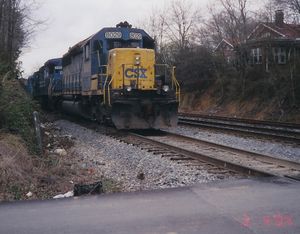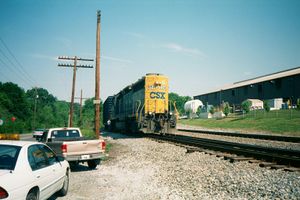Western and Atlantic Railroad
The Western & Atlantic Railroad of the State of Georgia (W&A) is a railroad that runs from Atlanta, Georgia, to Chattanooga, Tennessee. Founded on December 21 1836 as the Western and Atlantic Railroad of the State of Georgia, the line is still owned by the State of Georgia from Atlanta to CT Tower in Chattanooga.
This line is famous because of the Andrews Raid (commonly referred to as the Great Locomotive Chase), which took place on the W&A during the American Civil War on the morning of April 12, 1862.
Contents
Leasing
Through 1870, it was called the State Road, and was operated directly by the state under a superintendent appointed by and reporting to the governor of Georgia. On December 27 of that year, operations were transferred to the Western & Atlantic Railroad Company, a group of 23 investors including Georgia's wartime governor Joseph E. Brown, who leased it (both tracks and rolling stock) from the state for $25,000 per month. This expired exactly 20 years later on the same date in 1890, when the Nashville, Chattanooga & St. Louis (NC&StL) leased it for 29 years. Unfortunately, the railroad that was handed over to the Nashville, Chattanooga and St. Louis Railway was in very poor condition. The locomotives that were transferred to the Nashville, Chattanooga and St. Louis Railway consisted only of those listed on the 1870 lease as property of the State. All of the new ten-wheel locomotives purchased by Gov. Brown's Western and Atlantic Railroad Company were sold to other railroads. While most of the passenger equipment turned over was usable, almost all of the locomotives were condemnable and all of the freight cars were scrapped. The value of the locomotives was something that would be argued over for some twenty years. A major change made to the new lease in 1890 stipulated that all improvements made to the road by the lessee would become property of the state at the termination of the lease. Included in the defination of improvements were modifications to the facilities, right of way and new equipment purchased for use over that line including but not limited to passenger cars, freight cars and locomotives. As it turned out, the Nashville, Chattanooga and St. Louis Railway would continue to hold the lease to the Western and Atlantic Railroad of the State of Georgia until it was absorbed by its parent company, the Louisville and Nashville Railroad which was itself owned by the Atlantic Coast Line-one of the principal railroads in the Family Lines System and later CSX Transportation which continues to operate the line as the Western and Atlantic Subdivision (CSXT has a 99 year lease on the W&A from the State of Georgia).
After being captured by the Union in mid-1864 and until the end of the war in 1865, the line was briefly operated by the United States Military Railroad (USMRR).
Distances of Depots from Atlanta (1867 list)
| # | Name | Miles | Notes |
| 1 | Marietta, Georgia | 20 | begun in 1838, completed 1842 |
| 2 | Acworth, Georgia | 35 | |
| 3 | Allatoona, Georgia | 40 | Near Lake Allatoona |
| 4 | Etowah, Georgia | 45 | |
| 5 | Cartersville, Georgia | 47 | |
| 6 | Cass, Georgia | 52 | |
| 7 | Kingston, Georgia | 59 | |
| 8 | Adairsville, Georgia | 69 | |
| 9 | Calhoun, Georgia | 79 | |
| 10 | Resaca, Georgia | 84 | |
| 11 | Tilton, Georgia | 90 | |
| 12 | Dalton, Georgia | 100 | |
| 13 | Tunnel Hill, Georgia | 107 | tunnel opened October 31,1849 |
| 14 | Ringgold, Georgia | 115 | |
| 15 | Johnson, Georgia | 121 | |
| 16 | Chickamauga, Georgia | 126 | |
| 17 | Chattanooga, Tennessee | 138 |
Trains departed from Atlanta at 8:50AM and 7:00PM and arrived there at 1:35AM and 1:15PM.
Regauging
Prior to the Civil War, the rail gauge of most railroads in the South were exactly five ft (1.524 m) gauge. In 1886, the change to the northern standard of 4 ft 8½ in (1435 mm) was mandated on June 1, and the W&A accomplished this along all 138 miles (222 km) in less than 24 hours, beginning at 1:30PM on May 31 and finishing at 10:00 the next morning. This was done by over 400 men, prying up one rail and moving it closer to the other by exactly three inches (76 mm), leaving a compatible gauge of 4 ft 9 in (1.448 meters). The General and many other locomotives were also regauged at this time.

Great Locomotive Chase
On the morning of April 12, 1862, the locomotive General was stopped at Big Shanty (now Kennesaw) so that the crew and passengers could have breakfast. During this time, James J. Andrews and his Union raiders (Andrews Raiders), stole the General. The only damage the raiders did involved cutting telegraph lines and raising rails, although an attempt to burn a covered bridge failed. The train's conductor, William A. Fuller, chased the General by foot and handcar. At Etowah, Georgia, Fuller commandeered the Yonah and rode it north to Kingston, Georgia. At Kingston, conductor Fuller got the William R. Smith and headed north to Adairsville. The tracks were broken by the raiders two miles (3km) south of Adairsville and Fuller had to run the two miles by foot.
At Adairsville, Fuller got the locomotive Texas and chased the General. While all of this was happening, Andrews' Raiders were cutting the telegraph wires so no transmissions can go through to Chattanooga. With the Texas chasing the General in reverse, the chase went right through Dalton, Georgia, and Tunnel Hill, Georgia.
At milepost 116.3 (north of Ringgold, Georgia), Andrews' Raiders abandoned the General and scattered from the locomotive just a few miles from Chattanooga. After the chase, Andrews and most of his raiders were caught. After they were found guilty, Andrews and some members of his party were executed by hanging.
After the chase
When the chase was over, the General returned to service and after her service with the W&A was over, she retired to the L&N depot in Chattanooga. In 1962, 100 years after the chase, the L&N performed work necessary to allow the locomotive to operate under her own power for a series of appearances marking the 100th anniversary of the Andrew's Raid-more commonly known as the Great Locomotive Chase. The premier appearance was her run from Atlanta to Chattanooga over the Western and Atlantic Railroad. During this time, the City of Chattanooga was declaring war and wanting to keep the General for its own use and halted the train that was carrying the General at the L&N yard for a few days. After the dust had settled, the City of Kennesaw won and the General is currently resting at the Southern Museum of Civil War & Locomotive History where she can be seen today. The Texas is nearby at the Atlanta Cyclorama.
W & A in modern times
Today, the W&A has not changed much since the chase of 1862 (except for a few track realignments by the Nashville Chattanooga & St. Louis Railway). A marker indicating where the chase began is near the Big Shanty Museum in Kennesaw, Georgia. A marker for where the chase ended is at Milepost 116.3, north of Ringgold, GA, which is not far from the recently restored depot at Milepost 114.5.
A monument dedicated to Andrew's Raiders is located at the Chattanooga National Cemetery and it currently has the General on top of the monument and a brief history of the great locomotive chase.

